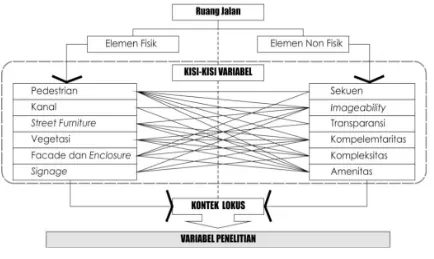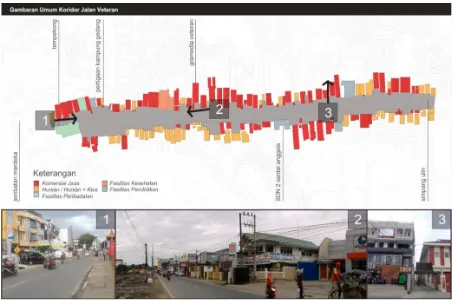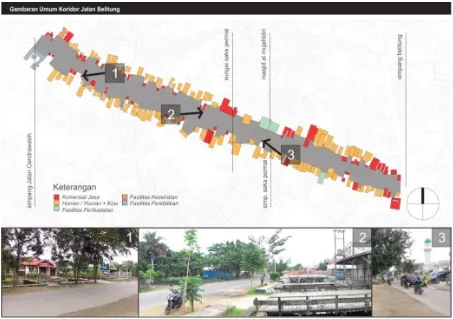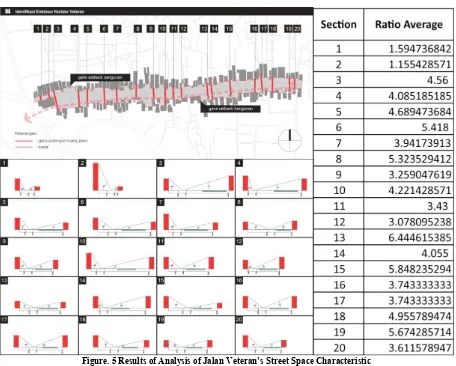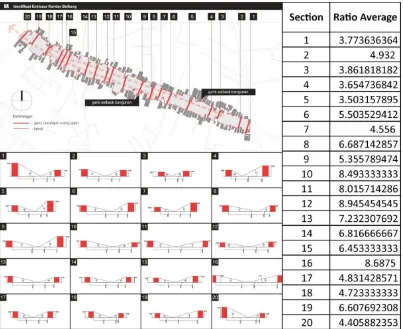CHARACTERISTICS OF STREET SPACE IN BANJARMASIN CITY
The street space is one of the typology of urban public spaces. The various functions of street spaces are among others, as a mode of transportation space, as a shared space for citizens, and similarly as an architectural expression of spaces that contains the collective memory of its citizens. This research is focusing on to the uniqueness of the network of streets and canals made up of street spaces in the city of Banjarmasin. The combination of streets and canals was further explored in order to get the spatial characteristics of the respective case. The purpose of this research is to determine how and why the street spaces in the city of Banjarmasin was changed and what components that influenced the characteristics of the space. This research uses an empirical paradigm with the case study method. The urban units of selected cases in this research are the corridors of Jalan Veteran and Jalan Belitung. The analytical method used is the typology of street spaces within either the two or three dimensions. Simplification and categorization patterns have been done to explore each of the main characteristics of the street spaces. Results of the analysis reveals the formal and informal characters of each street space that can influence the growth rate of the buildings, the changing face of the regions, and the changeover between the old buildings with that of the new ones. Dual canals are known as formal characteristic and single canal is known as informal characteristic. The conclusion from this research confirms that the canal elements at street spaces provide big influence to change the street spaces' characteristics.
Keywords: characteristic, street space, space transformation, canal
ABSTRAK
Some concepts such as MFPs (multi-function polis) which explains this phenomenon, namely, a condition where the street become a reference / center / embryo growth of a city / new urban space (Djokomono, 2010). Street space is understood as a form of the whole street network system. The existence of the street network has a close relationship with the formation of street space. According to Ellis (1986) in Ikaputra (2009) street space is divided into two (2) components, namely street wall and street space. Both of these components has an important role on orientation system, identity, to feel the space which affected the ratio between the two components. According to Rowe and Koetter (1986), in the city it is necessary to reminisce urban space a sequence-sequence support from the city. Sequence in question is an atmosphere of space in the city that has a sequence or vantage points that impressed provide serialized sequence from one sequence to another (Cullen, 1961; Rowe and Koetter, 1986).
Speaking of the streets in Indonesia and space is not separated from discussions in the colonial era. As we known in the historical process in Indonesia, many of the street network developed by the colonial government especially the Dutch colonial era. In this era of great walks developed by political motives possession, distribution, as well as the division of powers prescribed by the forced labor program (Daendels) Anyer-Panarukan road construction on the North side of the island of Java. In addition to mastery motive, distribution, and the division of power engineers in the Dutch colonial era also have knowledge of inundated. It is widely manifested in the Dutch’s fortress system that utilizes a network of channels for the needs of defense, transport, and irrigation. Some cities are developed with this model generally closely related to the development of the street adjacent to the channel. The development path has encountered many channels in several major cities in Indonesia such as Jakarta, Surabaya, Semarang, Palembang, Pontianak and Banjarmasin. Banjarmasin city is one of the cities that have experienced the colonial phase and leaving a legacy street network particularly in the Pulau Tatas. Tatas Island area is the territory of the first Dutch colonial government in defeating the kingdom of Banjar. 1860 was the year in which the soil Banjar fully controlled by the Dutch colonial government intervention as well as the commencement of street network in the city of Banjarmasin (Tichelman, 1931; David, 1997). Development of the streets by the Dutch colonial government in Banjarmasin has its special characteristics such as street networks assisted by channels. Construction of street network in the city of Banjarmasin in the post-independence era tend to be oriented to the landline network without expensive network of water (channels) or consideration of the sustainability of the great plan of the previous ruler. With the release of the consideration to tread the road network develops many unplanned and tend to adjust to the plots of old as well as consideration of ease of dispute resolution and redress swap.
Based on some perspectives above it can be formulated general questions for this study are: How is the development of street space with characteristics contented in a city? The purpose of the research that can be explained are: how the process of development of street space in the city of Banjarmasin and factors that influenced the development of street space in the city of Banjarmasin.
2. LITERATURE
Technically road is one part of the engineering disciplines, especially in the field of engineering. The road from a social perspective has a different understanding of the elements of engineering that as one container of activities especially for people who use the street as a space of social media in a city or village. According Moughtin (2003) is not just an access road, but as an arena of social expression in the urban space. Davies (2000) explains that the road space can function as a social space (street as social places). An understanding of the above certainly has a lot to explain that the other side of mere functions and engineering elements. Scientifically city street can be interpreted as a linear network that sits between buildings (Rapoport, 1977). The road is also interpreted as a network (networks) linking the activity in a space and time (Moudon, 1994). Linearly road can be classified into 2 (two), namely: menurus (liniearity) and being at the same time have an endpoint or milestones (linearity and point of arrival).
3. METHODOLOGY
Base of this street space research is empiricism. Empiricism Paradigm has a view that knowledge is not but should be proven by the context field. With this perspective, the efforts deduction would simply produce a grating for research work procedures. With this point of view also the quantitative and qualitative approaches can be synergized in the form of results or data.
Empirical Methodology used in this study is the case study method. The case study method has a foundation of scientific social science developed from methods in qualitative research. According to Yin (1981) in the Dooley (2002) describes the kinds of data that can be used in the research process. Furthermore, according to Johansson (2002) case study has its own character in the election as a unique case, a case that has a complex unit, and cases that have a temporary nature.
Research techniques used were observation and interview key to obtain primary data. Perform searches and historical planning documents to obtain secondary data. Method of analysis using the technique of pairing pattern (pattern matching) are conducted in parallel with the analysis of time series (time series) and concluding with an explanation building (building explanation) associated with the transformation of the patterns that prevail in research object. Research variables are the elements of street space associated with physical content and elements of street space associated with non-physical content. Based on a literature review showed 6 (six) for the categories of physical variables and 6 (six) for the categories of non-physical variables. Depiction is used as a basis in the field of work procedures. Depiction is possible to experience the addition or subtraction of variables based on the context of the research sites.
Figure. 1
Depiction of Research Variabels
4. STREET SPACE CHARACTERISTIC
4.1. Corridor of Jalan Veteran
services. In 2010 to date (2016) corridor of Jalan Veteran change means street space of spatial aspect. This change is the removal of the building located on the banks of the channel of Jalan Veteran as a consequence of the channels normalization program in Banjarmasin. Other changes before the study process, which is known banks of the channels expansion plan into green space and public open space of the riverbank park.
Based on the understanding from the identification of the elements of physical and non-physical elements that exist in the corridor of Jalan Veteran then obtained some of the research findings as follows. Pedestrian understood not become an important element in the life of the local community and pedestrian functions tend to be overlapped with the functions of utility and parking. Channels that are on the south side of Jalan Veteran are currently undergoing significant changes, closed by building until an open area with no buildings. Street furnitures are dominant along Jalan Veteran’s corridor are generally street furnitures that doubles the utility functions such as street lighting and no other types of street furniture such as flower pots, chairs, shelter, trash-bin and other markers. Vegetation along Jalan Veterans corridor are generally in the form of roadside trees are very few in number. Some common private tree properties or trees that were in the plots. Facade of the shophouse buildings along Jalan Veteran’s corridor dominated by a form of 3-4 storeys have associated with signage. Signage located along corridor of Jalan Veteran generally fall into the range of typologies wall sign and a free standing sign. Enclosure space corridor along Jalan Veteran generally have a ratio of 1: 3 to a ratio of 1: 6 with anomalous addition of channel width as parameters hospitality determinant ratio changes enclosure. Sequences and imagebility along corridor of Jalan Veteran do not have strong character and the same relative space of transparency found along corridor of Jalan Veteran is generally determined by the facades of buildings, fences and the expansion of space in the courtyard of the building. The complexity of the space found along corridor of Jalan Veteranare determined by three things: billboards / signages, street vendors and building facades. Amenities contained in this corridor located on the territory of the pagoda (tempekong) people understand as identity Chinatown neighborhood.
Figure. 2 Image of Jalan Veteran’s Street Space
4.2. Corridor of Jalan Belitung
average height of 2 floors which are generally still dominated by residential or residential functions that have been changed into a commercial (restaurant). Jalan Belitung’s corridor today generally still have image of street space in the past. Function mixture of residential, commercial and other public facilities enrich the functions of enclosure space formed in this corridor. Corridor of Jalan Belitung based function is generally dominated by commercials and settlements functions. In the 2000s in this corridor there was a market phenomenon spilled or better known as the tungging market. This phenomenon takes place daily, especially late in the afternoon until the evening where traders utilize street space as a place to sell their goods. In the span of the last eight years this phenomenon began sterilized by performing the merchants reconcentration of street space into a place which is currently in Kalindo Market. A significant change in the last five years in this corridor happenes was channel normalization program by strengthening the walls of the channel with concrete construction (box culvert). Almost along the south side of the Jalan Belitung’s channel has experienced a strengthening of the wall construction of the channel, while the channel on the other side understood will get a similar intervention.
Figure. 3 Image of Jalan Belitung’s Street Space
5. FINDING AND RESULT
Figure. 4 General Results of Analysis of Jalan Veteran’s Street Space Characteristic
Figure. 5 Results of Analysis of Jalan Veteran’s Street Space Characteristic
Veteran that the channel is an additional parameter in determining the ratio of street space in corridor of Jalan Belitung is also understood to have such things. The difference with the case of Jalan Veteran unit is in the fabric of space channels, especially the difference in channel width. Channel on the north side of the corridor Jalan Belitung tend to be narrower than the channel on the south side of the street. Differences known channel width ranging from 1 to 2 m.
Figure. 6 General Results of Analysis of Jalan Belitung’s Street Space Characteristic
Figure. 7 Results of Analysis of Jalan Belitung’s Street Space Characteristic
6. CONCLUSION
street space. Physical aspects divided into two channels which by their nature tend to be non-formal single channel and dual channel tends to be formal. Lots of transparency into non-physical aspects that can be complementary indicators in explaining the characteristics of street space in the city of Banjarmasin. The condition is believed to be also valid in the other streets in the city of Banjarmasin with similar characteristics and in particular to the streets of Dutch colonial heritage.
BIBLIOGRAPHY
1. Bintarto, R. (1989). Interaksi Desa-Kota dan Permasalahannya. Jakarta: Ghalia Indonesia. 2. Cullen, Godon. (1961). The Concise Townscape. London: Architectural Press
3. Daud, Alfani. (1997). Islam dan Masyarakat Banjar: Deskripsi dan Analisa Kebudayaan Banjar. Jakarta: Rajawali. Press.
4. Davies dan Llewelyn. (2000). Urban Design Compendium 1. London. English Partnerships The Housing
Corporation
5. Djokomono, Imam. (2010). Bahan Kuliah Elemen Perancangan Perkotaan. Universitas Gadjah Mada.
Yogyakarta
6. Dooley, L. M. (2002). Case Study Research and Theory Building. London: Sage Publications.
7. Ewing, Reid. et al (2014). Streetscape Features Related to Pedestrian Activity. Paper TRB 2014 Anual Meeting. Utah: University of Utah
8. Hadinata, Irwan Yudha. (2015). Kanal Perkotaan Sebagai Bentuk Simbiosis Keberlanjutan Kota Diwilayah
Rawa Pasang Surut. Prosiding Seminar Space #2. Denpasar: Universitas Hindu Indonesia
9. Ikaputra. (2009). Materi Perkuliahan MDKB: Street 1 dan Steet 2. Universitas Gadah Mada. Yogyakarta 10. Johansson, R. (2002). Case Study Methodology. Stockholm: Royal Institute of Technology
11. Krier, Rob. (1979). Urban Space. London: Academy Edition.
12. And Design. New York: Van Nostrand Reinhold
13. Moughtin, Cliff. (2003). Urban Design: Street and Square. Third Edition. London: Architectural Press
14. Rapoport, Amos. (1977). Human Aspects of Urban Form: Towards a Man-Environment Approach to Urban
Form and Design. Milwaukee: University of Winconsin
15. Rowe, Colin and Fred Koetter. (1986). Collage City. The MIT Press, Cambridge
16. Saiki, Takahito et al. (2002). Towards A New Generatiaon of Garden City. Kobe: Kobe Design University 17. Salim, A. (2006). Teori & Paradigma Penelitian Sosial. Yogyakarta: Tiara Wacana
18. Spreiregen, Paul D. (1965). The Architecture Of Towns And Cities. New York: McGraw-Hill Book
Company.
19. Watson, Donald et al. (2003). Time Saver Standart for Urban Design. New York: Mc Graw Hill
